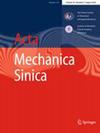On faults induced stress shielding to account for the formation of deep-buried reservoirs
Abstract
It is commonly accepted that the formation of oil and gas reservoirs in deep-buried strata is almost impossible due to the huge compaction of in-situ crustal stresses. Nevertheless, recent hydrocarbon explorations in the Tarim Basin have discovered reservoirs at depths exceeding 8 km. The reservoirs exhibit a strong correlation to the strata’s faults and large fractures, yet the precise underlying mechanical mechanism remains obscure. To illuminate how the faults may facilitate the existence of such deep-buried reservoirs, we consider three ideal scenarios involving unconventional hole-crack interactions under remote biaxial compression. Our focus is on the stress concentration of the hole, influenced by the long main cracks. Closed-form compressive stress solutions are obtained based on our simple theoretical models, showing that long cracks significantly reduce the stress concentration of nearby holes. We quantify the reducing effect of the cracks’ angle, surface friction, and pressure on the maximum shear and von Mises stresses around a hole, combining with finite element analysis results. The stress shielding effect is qualitatively consistent with the available experimental observations that the deep-buried caves are often located near the faults and large fractures in carbonate strata. Our results will be beneficial for future exploration of superdeep petroleum reservoirs.

 求助内容:
求助内容: 应助结果提醒方式:
应助结果提醒方式:


